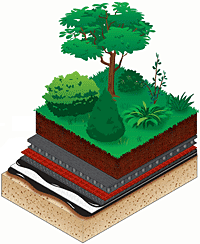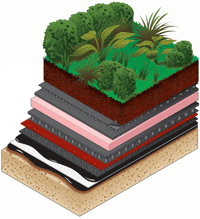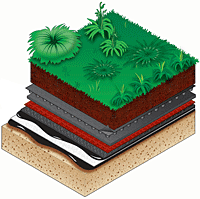Green Roofing
|
The MacCallen Building |
The Green Roofing Trend
Benefits to Building Owners
Benefits to the Environment and Surrounding
Community
A Green Roofing System
Marshall has become a leading contractor in this emerging commercial roofing specialty.
Green roofing has been around for a long time. It became popular in European urban areas over 50 years ago. In 2000-2001 Chicago’s City Hall was covered with one million square feet of roof top gardens. Yes it IS environmentally friendly, but green roofing also offers some bottom-line benefits that are causing this trend to more and more be in the minds and on the lips of architects/specifiers and building owners/managers.
- Green roofing prevents warm-weather energy spikes and can decrease electric bills for commercial buildings.
-
Green roofing creates higher value, more usable
space.
- With their rooftop gardens green roofs offer a green-space amenity – pleasant outdoor settings in urban environments.
- Given proper care and maintenance a green roof can last 40 to 50 years, justifying its higher initial cost through life-cycle costing. Local, state and federal “green” tax incentives can also figure into the analysis of a green roof’s return on investment. These include LEED (Leadership in Energy and Environmental Design) tax credits.
- A developer may also find green roofing “permit friendly” because it contributes to the quality of life of the local community.
Benefits to the Environment and Surrounding Community
Green roofs provide two major benefits to the urban environment and surrounding community. They reduce stormwater runoff volume and they lessen the urban-heat-island effect.
Stormwater Runoff
According to the
Environmental Protection Agency, stormwater runoff
can flow over impervious surfaces and pick up
pollutants that affect the quality of the water
supply. Green roofing can;
- Reduce and delay stormwater runoff volumes,
- Enhance groundwater recharge with less runoff being diverted to overflow channels,
- Reduce stormwater pollutants,
- Reduce sewer overflow events.
Urban Heat Islands
According to the Urban
Heat Island [research] Group, on warm summer days,
the air in urban areas can be 6-8 degrees Fahrenheit
hotter than in surrounding areas. Scientists call
these city areas "urban heat islands." The higher
temperatures in urban heat islands increase the need
for air conditioning and raises pollution levels.
The "heat island effect" is caused in part by less
vegetation and dark surfaces, that absorb more heat
from the sun. Green roofs reduce dark roofing
surfaces along with the heat they absorb and provide
more vegetation. On a 95 degree Fahrenheit day, for
example, a green roof is 95 degrees, while a
conventional dark roof is 160 degrees.
Technically, what is a green roof? A green roof is a protected membrane assembly with landscape material on top.
There are two typical assemblies.
The Intensive Assembly is characterized by deep soil depths (six inches and up).
- It supports a wide variety of plantings, shrubs, and trees.
- It requires irrigation and ongoing maintenance.
- It requires the underlying structure to be designed for a heavy load.

The Extensive Assembly is characterized by shallow soils depths (around 3 inches).
- It supports low growth plants (typical drought resistant sedums and grass).
- It requires no irrigation.
- It needs one year of maintenance until plantings have matured.
- It is lightweight (25-30 pounds per square foot saturated).


